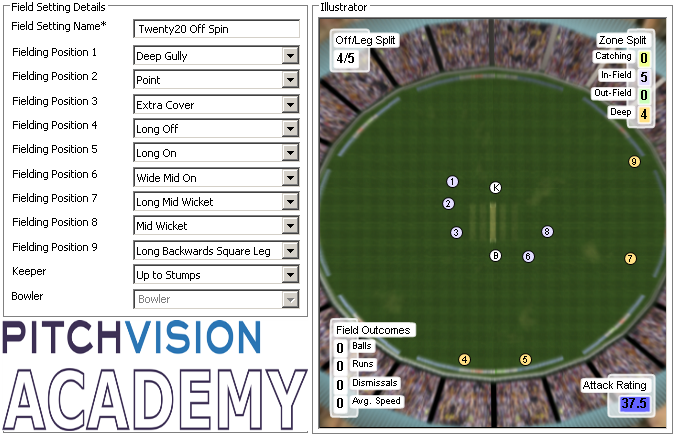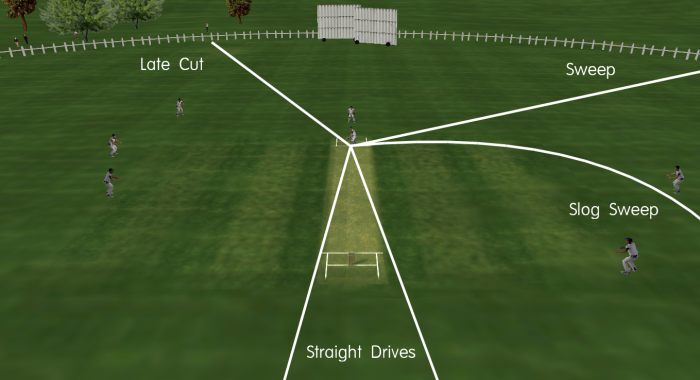|
 This article is part of "The complete guide to cricket field settings" series. This article is part of "The complete guide to cricket field settings" series.
The middle overs of a Twenty20 game are the black sheep of cricket: unglamorous and disregarded and nobody likes talking about them.
But a loss of focus in this period is all it takes to lose a close match where every stolen single counts.
Even in short format games (be they 16 8 ball overs of traditional evening cricket or the more modern Twenty20) there is a period where the game pace changes and there is a lull before the final push for the line.
Usually this takes place between overs 6-12, but can be longer if wickets are falling (or indeed shorter if the batsmen are carving it to all parts on a flat track). It's the time for spinners to make a mark and restrict scoring.
In this field setting we are talking the IPL as a model. That means a field restriction of 4 players inside the 30 yard fielding circle and a maximum of 5 on the leg side.
We are also going to assume the pitch is a 'typical' Indian wicket with not much pace or bounce but some turn.
Bowling to this field
Your main role in the middle overs is to restrict the score and frustrate batsmen into hitting out before they are ready. For that reason your standard line needs to be straighter and you give the ball less flight than you would in longer formats.
Aim to get the batsman playing forward as if he or she can go back the have more time to work the ball into the gaps. Pitching the ball somewhere around 12-14 metres from the bowlers popping crease should do the job. Use the batsman's footwork reaction as a guide to length.
These tactics force the batsman to play straight or into the leg side where you can cut off the shots with your boundary runners.
Extra cover and mid off are key positions for you, stopping drives which will be most batsmen's escape route from the pressure. Place extra cover too square and he becomes redundant.
You can bowl to this field from over or round the wicket.
Bowling variations
As the batsman is looking to score off more deliveries than any other format, you can't let them get used to your bowling line, length or pace. To do so means they can premeditate an aggressive shot and score easily against you.
That's why it's important to vary from your stock delivery often if the batsman is on top:
- Flight. The ability to place the ball in the same spot but with different heights on the ball is very deceptive. On slow wickets you can vary the flight of almost every ball, or just throw in the odd flatter/loopy ball if you feel the batsman is in a rhythm.
- Arm ball. The ball that drifts away from the right hander is an excellent way to deceive the batsman and get a dot ball (or turn a boundary into a single). It's also a wicket taking ball. Pitch it further up and with a middle stump line.
- Doosra. If you can bowl the one that goes the other way (a rare skill), bowl it at middle stump on a length and hope it catches the edge or the top of off stump.
- Yorker. The very full ball is not just for the seamers. It's hard to hit a full and straight ball anywhere but down the ground.
- Position on the crease. Adjusting where you deliver the ball can upset a batsman's timing. Try bowling from bowling crease instead of the popping crease, or going wider on the crease to change the angle.
Avoid bowling
Like all fields, loose bowling can be punished, but you do have protection in key areas to try and restrict the easy flow of runs.
- Too many stock balls. If the batsman realises you are putting the ball on the same spot without variation can work the ball around for singles and twos using the pace of the ball and the gaps in the spread out field
- Too many unpracticed variations. Variations are vital in T20, but if you bowl them without having practiced them first they just end up being bad balls. Make sure every variation you try in the middle has had plenty of work in the nets.
Field Variations
- To add pressure to a new batsman, deep gulley can move to slip or point can go to silly point (although not for more than a couple of balls)
- Mid off can be at orthodox or on the edge of the circle.
- Point can move out to the boundary as an off side sweeper.
- If the ball is turning consider a fielder saving one on the leg side behind square.
- Fielders in the ring can be tight on the single to squeeze the batsman or on the edge of the circle giving one but more likely to save a boundary.
Batting against this field

The batters main aim in this phase of the game is to be workmanlike and disciplined. The field is spread so hitting boundaries is harder, but scoring singles and twos is easier. Six an over is a reasonable rate and can be done by rotating the strike with minimum risk.
Play straight, looking to score in an arc between mid off and midwicket, especially if the bowler drops short so you can play back foot drives and pulls with control.
The late cut to anything wide outside off can pick up runs if it beats the man at deep gulley.
Don't get tempted into going 'inside out' and driving against the spin as this is a risky path that can lead to you missing or mistiming the ball. If you need to improvise try hitting over the leg side by clearing the front leg.
The sweep is productive against over the wicket off spin, but it can be risky if the bowler is going around the wicket because the line is straightening onto the stumps.
Images supplied by PitchVision - Coach Edition software
Discuss this article with other subscribers
|

.jpg)




.jpg)


